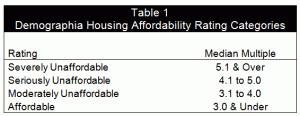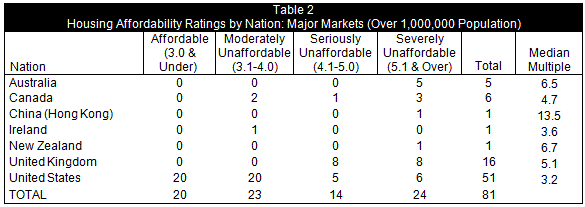Smart Growth/Urban Containment Continue to Drive Unaffordable Housing in 7 Nations
We have just released the 9th Annual Demographia International Housing Affordability Survey covering 337 metropolitan markets in Australia, Canada, China (Hong Kong), Ireland, New Zealand, the United Kingdom and the United States. As usual, the most unaffordable markets are those in with urban containment policy (also called by other names, such as smart growth and compact cities policy). The Survey uses the Median Multiple to evaluate housing affordability.
The Demographia International Housing Affordability Survey employs the “Median Multiple” (median house price divided by gross before tax annual median household income) to rate housing affordability (Table 1). The Median Multiple is widely used for evaluating urban markets, and has been recommended by the World Bank and the United Nations and is used by the Harvard University Joint Center on Housing.
Historically, among the metropolitan areas outside Hong Kong, the Median Multiple was typically at 3.0 or below, before the adoption of urban containment policies. Urban containment policies ration land for development, and as economics would predict, this raises the price of land and thus the price of housing.
Severely Unaffordable Major Markets
The most unaffordable major markets (over 1,000,000 population) are Hong Kong, with a Median Multiple of 13.5, Vancouver with a median multiple of 9.5 and Sydney with a median multiple of 8.3 (Table 2).
The most severely unaffordable US major markets (over 1 million population) are San Jose, at 7.9, San Francisco, at 7.8, San Diego, 6.4, New York, 6.2, Los Angeles, 6.2, and Boston, 5.1. Each of these markets experienced a substantial house price escalation during the housing bubble and a substantial loss in house prices when the bubble burst.
In Canada, both Toronto (5.9) and Montréal 5.1 were rated severely unaffordable, in addition to Vancouver.
All major markets in land rich Australia are rated severely unaffordable, including Sydney (9.3), Melbourne (7.5), Brisbane (5.8) , Perth (5.9) and slow-growing Adelaide (6.5). New Zealand’s only major market, Auckland is also rated severely unaffordable, at 6.7
Among metropolitan areas with less than 1 million population, Honolulu was the most unaffordable in the seven nations, at 9.3.
In the United Kingdom, London (7.8), the London exurbs (6.8), Plymouth (7.3), Bristol (5.7), economically depressed Liverpool (5.3), economically depressed Newcastle (5.2), Birmingham (5.1) and Sheffield (5.1) were also rated severely unaffordable.
Affordable Markets
At the same time, affordable markets remain, even in the metropolitan areas with the highest growth rates. For example, Dallas-Fort Worth, Houston and Atlanta, which are among the fastest-growing Metropolitan areas with more than 5 million people in the high income world, housing remains affordable. As has been the case throughout the nine years of the Survey, the most affordable housing has been in Metropolitan areas with the more traditional liberal land-use policies that have been replaced by urban containment policies in many metropolitan areas.
Understanding and Dealing with the Problem
The issue driving housing affordability is not demand. It is a supply problem driven by the destruction of the competitive land supply by overzealous land regulation. Former Reserve Bank of New Zealand Gov. Donald Brash squarely cited the cause in his introduction to the 4th Annual Demographia International Housing Affordability Survey who said that the one issue separating markets with housing affordability from on affordable housing “is the severity of the artificial restraints on the availability of land for residential building.”
Hon. Bill English, Deputy Prime Minister of New Zealand, who is leading an effort to reform his nation’s destructive policies, describes the problem further in his introduction to this year’s Survey:
It costs too much and takes too long to build a house in New Zealand. Land has been made artificially scarce by regulation that locks up land for development. This regulation has made land supply unresponsive to demand. When demand shocks occur, as they did in the mid-2000s in New Zealand and around the world, much of that shock translates to higher prices rather than more houses.
Housing Affordability and a Sustainable Economy
There has been increasing attention to the challenging demographic trends that could materially reduce future standards of living. Birth rates have plummeted, while the share of the population that is elderly has increased substantially. As a result, government financial obligations could overwhelm the ability of nations to pay. Higher than necessary housing costs would make it even more difficult to meet these obligations.
Further, surveys indicate that many households are having children later, or not at all because housing conducive to raising children is unaffordable. There are generally lower fertility rates in urban cores, with their higher density housing than in the more dispersed suburbs, with their detached and semi-detached housing.
But the consequences of stagnant or declining standards of living and rising poverty could be even greater. Harvard economist Harvard economist Benjamin Friedman concluded that continuing improvements in the quality of life are required for social sustainability, in his The Moral Consequences of Economic Growth.
Affordable housing is thus a critical component of economic sustainability. Yet, the “conventional wisdom” in land-use policy favors urban containment strategies that severely ration land for development, materially raising its price.
There are indications that perspectives are changing. New York University Professor Shlomo Angel writes in his book Planet of Cities of the importance of housing affordability and argues against urban planning restrictions that restricting adequate housing to ordinary households.
A team of UK academic researchers has questioned the appropriateness of assuming that urban containment should be the default land use option. This is an important development, since much of urban planning is committed to outlawing more liberal land-use policies.
Urban policy needs a “reset.” The emphasis should be shifted away from “designing” urban areas to facilitating a better standard of living for the people who live in them. In his epic Civilization: The West and the Rest, historian Niall Ferguson, in his Civilization notes that “The success of the civilization is measured not just in its aesthetic achievements but also, and surely more importantly in the duration and quality of life of its citizens.” This requires greater affluence and less poverty, both of which require more affordable housing.


Too bad they didn’t have Japan on that list… Where you literaly have to sign over your first born.
No serious, they have multi-generational loans.
“Affordable housing is thus a critical component of economic sustainability. Yet, the “conventional wisdom” in land-use policy favors urban containment strategies that severely ration land for development, materially raising its price.”
Affordable housing is critical, without a doubt.
I find it interesting that Houston, a city with effectually zero zoning laws, is one of the fastest growing and more affordable cities in the U.S.
I suppose that Texas’ libertarian leanings are paying off.
I can’t help but think of Hayek’s discourse on central planning when I read this article. In an economy free from gvoernment interference, the market would ration its need for different types of land based upon demand. With these urban containment policies we are altering the supply and skewing prices. Hardly pareto efficient.
.
In a country where we pride home ownership, I’m surprised the empirical evidence doesn’t get more attention. Not that politicians really care about what is actually good, only about what sounds good. Without destroying the whole discipline of urban planning, there must be a way to protect natural resources and keep pollution away from homes and families while still letting city land-use operate as a free market. Policies that support industry clusters might keep manufacturing and industry away from residential zones.
.
The more I think about it, the issue is of urban planning is certainly complex and beyond my limited understanding. I think the important question is how much more prevalent will urban planning be in the decades to come? What will be the result? Will we continue to see divergence between the cities that practice containment policies and those that don’t? With the economy becoming more based on intangibles, will the issue be as important in the future? Will metropolitan areas begin to decentralize as they expand?